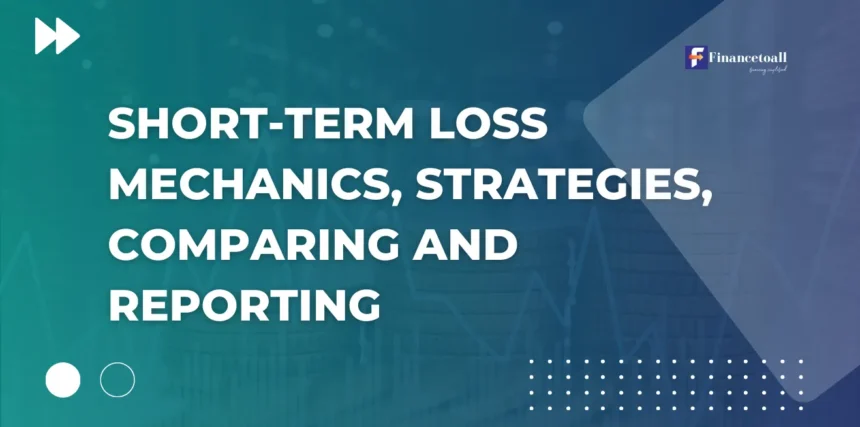Short-term losses are a normal part of managing investments. Whether you’re dealing with stocks, real estate, or other assets, knowing how short-term losses function, their tax consequences, and ways to lessen their impact is vital for reaching your long-term investment objectives. This article covers the basics of short-term losses, including definitions, mechanics, and practical measures to transform losses into tax benefits.
What is a Short-Term Loss?
Understanding the concept of a short-term loss is crucial before delving further. In the world of finance and investing, a short-term loss occurs when you sell an asset—such as stocks, bonds, or real estate for less than its original purchase price within a period of one year or less. The difference between the sale price and the cost basis (purchase price plus related costs) constitutes the capital loss.
For example, if you bought shares of stock for $1,000 and sold them six months later for $800, you would realize a short-term loss of $200. While this short-term capital loss reduces the value of your investment, it can provide tax benefits when properly managed.
Short-term losses contrast with long-term losses, which are realized after holding an asset for more than a year. This distinction is critical because short-term and long-term losses are taxed differently, as we’ll explore in detail later in the article.
Key Takeaways
Why Do Short-Term Losses Occur?
Short-term losses happen due to different factors, such as market fluctuations and issues specific to companies. Let’s look at some typical reasons behind short-term losses:
- Market Volatility: Stock prices and other asset values can fluctuate rapidly due to shifts in investor sentiment, macroeconomic news, or unexpected global events. These fluctuations often lead to short-term price drops, resulting in losses if investors sell during a downturn.
- Economic Factors: Broader economic changes, such as interest rate adjustments, inflation, or geopolitical instability, can lead to short-term losses across different asset classes. For example, rising interest rates may cause bond prices to fall, while inflation might erode the value of stock market investments.
- Company-Specific Challenges: Individual stocks can experience significant price drops due to poor earnings reports, management missteps, product recalls, or regulatory issues. If an investor sells in response to these developments, they may incur a short-term loss.
- Speculative Investments: High-risk investments, particularly in speculative stocks, cryptocurrencies, or futures contracts, are often more volatile and prone to short-term losses. Investors who engage in short-term trading strategies, such as day trading, are more likely to experience these losses due to the unpredictable nature of such assets.
Mechanics of Short-Term Losses
To manage short-term losses effectively, it’s important to understand how they function in practice. The mechanics of short-term losses involve several key concepts, such as cost basis, sale price, and net capital losses.
Cost Basis
The cost basis is the original value of an asset for tax purposes. It includes the purchase price plus any associated costs, such as brokerage fees or commissions. When an asset is sold, the cost basis is subtracted from the sale price to determine whether a gain or loss has been realized.
For example, if you purchased a stock for $10,000 and paid $100 in commissions, your total cost basis would be $10,100. If you later sold the stock for $9,500, your capital loss would be $600.
Sale Price
The sale price is the amount you receive when you sell an asset. The difference between the sale price and the cost basis determines whether you have a capital gain or capital loss. If the sale price is lower than the cost basis, a capital loss occurs.
Net Capital Losses
When calculating your total capital losses, it’s important to consider your overall portfolio. Net capital losses are calculated by offsetting capital gains with capital losses. If your losses exceed your gains in a given year, you may deduct up to $3,000 in net losses against ordinary income ($1,500 if married filing separately). Any remaining unused capital losses can be carried forward to future tax years, which is a valuable tool in tax planning.
Example of Calculating a Short-Term Loss
Let’s assume you bought two stocks in the same year: Stock A for $5,000 and Stock B for $3,000. Six months later, you sold Stock A for $4,000, realizing a $1,000 short-term loss, and Stock B for $4,500, realizing a $1,500 short-term gain. In this case, you would offset your loss with the gain, resulting in a net capital gain of $500. However, if your losses exceeded your gains, you could apply the excess to reduce your overall tax liability, as discussed in the next sections.
Key Considerations for Reporting Short-Term Losses
Properly reporting short-term losses is essential to taking full advantage of the tax benefits they offer. Reporting involves filling out specific IRS forms and adhering to capital loss limitations.
IRS Forms for Reporting Losses
To report short-term capital losses, you must file IRS Form 8949 and Schedule D. Form 8949 is used to report the details of the transactions that resulted in gains or losses, such as the date of purchase, sale price, and cost basis. Schedule D is used to summarize your total capital gains and losses and to calculate the net capital loss if your losses exceed your gains.
It’s critical to ensure that all information reported is accurate and complete. Mistakes in reporting could lead to IRS penalties or a disallowed deduction.
Net Capital Loss Deduction Limit
As mentioned earlier, the IRS limits the amount of net capital losses that can be deducted against ordinary income to $3,000 per year ($1,500 for married individuals filing separately). This limitation means that while you can use losses to offset gains without limit, any excess capital losses beyond the deduction limit must be carried forward to future years.
For instance, if you have capital losses of $8,000 but no capital gains, you can deduct $3,000 against your ordinary income in the current tax year. The remaining $5,000 would be carried forward to future years to offset future capital gains or further reduce ordinary income.
Comparing Short-Term and Long-Term Losses
While this article focuses on short-term losses, it’s important to understand how they differ from long-term losses and how both can be strategically managed to reduce your tax liability. Let’s explore the key differences between short-term and long-term losses.
Tax Rates on Short-Term vs. Long-Term Losses
One of the most significant distinctions between short-term and long-term losses lies in the tax treatment of gains associated with each type of loss. Short-term gains, which result from the sale of assets held for less than a year, are taxed at your ordinary income tax rate, which can be as high as 37% for high-income taxpayers. By contrast, long-term capital gains are taxed at more favorable rates, ranging from 0% to 20%, depending on your income bracket.
This difference in tax rates creates an incentive for investors to hold onto assets for at least one year to qualify for the lower long-term capital gains tax rate. However, in the event of a loss, it’s often beneficial to realize short-term losses to offset gains and reduce your tax burden.
Offsetting Gains with Short-Term Losses
Both short-term and long-term losses can be used to offset gains, but the order in which they are applied is important. Short-term losses must first be used to offset short-term gains, which are taxed at higher rates. Similarly, long-term losses are used to offset long-term gains. If you have both types of losses and no corresponding gains, the losses are combined and can offset up to $3,000 of ordinary income.
The Emotional Impact of Short-Term Losses
Investors tend to react more strongly to short-term losses than long-term losses due to the psychological effects of loss aversion. This phenomenon, where people feel the pain of a loss more acutely than the joy of a gain, can lead to impulsive decisions such as selling assets too quickly. Understanding the difference between temporary market fluctuations and long-term trends is crucial for maintaining a balanced perspective and avoiding knee-jerk reactions to short-term losses.
Managing Short-Term Losses in the Context of Investment Goals
For most investors, investment goals are focused on long-term growth and achieving financial security over time. However, short-term losses are a normal part of the investment process. The key is to not let these losses derail your long-term strategy. Managing short-term losses involves maintaining a diversified portfolio, setting clear investment goals, and using tax-efficient strategies like tax-loss harvesting to mitigate the impact of capital losses.
Short-Term Loss vs. Long-Term Loss: Key Differences and Implications
| Aspect | Short-Term Loss | Long-Term Loss |
| Duration | Occurs within a year | Persists for more than a year |
| Causes | – Market Volatility – Economic Shifts – Speculative Trading | – Fundamental Weakness – Economic Cycles – Structural Changes |
| Tax Treatment | – Less favorable tax treatment – Can offset short-term gains, often taxed at higher rates | – More favorable tax treatment – Can offset long-term gains, potentially taxed at lower rates |
| Emotional Impact | – Immediate emotional reactions – Can lead to impulsive decisions | – Long-term stress – Leads to deliberate strategic reassessment |
| Recovery Strategies | – Hold steady and wait for recovery – Use diversification and stop-loss orders – Focus on long-term goals | – Reassess fundamentals – Adjust investment or business strategy – Consider tax strategies – Be patient and plan carefully |
| Management Approach | – Stay calm during market volatility – Avoid hasty decisions | – Analyze underlying issues – Make significant strategy changes if needed |
| Typical Scenario | – Quick market declines or fluctuations – Temporary downturns | – Prolonged recessions or bear markets – Structural or fundamental declines in value |
Reporting Short-Term Losses
When it comes to reporting short-term losses, accuracy and thoroughness are essential. Failure to report losses properly could result in penalties or missed opportunities for tax savings.
Steps to Report Short-Term Losses
- Gather Necessary Documentation: Collect all relevant documents related to the sale of assets, including brokerage statements, transaction confirmations, and tax forms provided by your financial institution. These will provide the details you need to report your losses accurately.
- Complete Form 8949: As noted earlier, IRS Form 8949 is used to report the details of each transaction, including the purchase price, sale price, and the date of the transaction. Separate short-term and long-term losses on this form.
- Summarize on Schedule D: After completing Form 8949, summarize your total gains and losses on Schedule D, which is then included with your federal tax return.
- Apply Net Capital Losses: If your capital losses exceed your capital gains, apply up to $3,000 of net losses to reduce your taxable ordinary income. Carry forward any unused capital losses to future years.
Example of Reporting a Short-Term Loss
Let’s assume you sold shares of Stock A for $10,000, which you had purchased for $12,000 six months earlier. You realized a short-term loss of $2,000. On Form 8949, you would report the details of this transaction, and on Schedule D, you would summarize your total gains and losses.
If you had additional capital gains of $5,000 from other investments, you could offset the gain with your $2,000 loss, reducing your net capital gains to $3,000. This strategy not only lowers your taxable gains but also ensures that you pay less in capital gains taxes.
Tax Implications of Short-Term Losses
Short-term losses can offer significant tax benefits when properly managed. Let’s dive into the specific tax implications of realizing short-term losses and how you can use them to your advantage.
Offsetting Capital Gains with Losses
One of the primary tax benefits of capital losses is their ability to offset capital gains. For example, if you realized a capital gain of $5,000 from the sale of one stock but incurred a capital loss of $3,000 from the sale of another, you can offset the gain with the loss, reducing your taxable gain to $2,000. This strategy is particularly useful for short-term capital gains, which are taxed at higher rates than long-term gains.
Limits on Capital Loss Deductions
As discussed earlier, the IRS imposes a limit on the amount of net capital losses that can be deducted against ordinary income. The limit is set at $3,000 for individual filers and $1,500 for married individuals filing separately. Any excess capital losses can be carried forward to future tax years, where they can be applied against future capital gains or used to reduce ordinary income further.
Net Investment Income Tax (NIIT)
High-income taxpayers may also be subject to the Net Investment Income Tax (NIIT), which adds an additional 3.8% tax on certain types of investment income, including capital gains and short-term gains. Understanding how the NIIT affects your overall tax liability is essential, particularly if you have significant investments in taxable accounts. Tax-loss harvesting can be an effective way to minimize the impact of this additional tax.
Example of Tax Savings Through Loss Harvesting
Consider an investor who realizes a capital gain of $50,000 from the sale of a stock. At the same time, they realize capital losses of $30,000 from other investments. By applying the capital losses to offset the gains, the investor reduces their taxable gain to $20,000, significantly lowering their overall tax burden.
Additionally, if the investor’s net losses exceed their gains, they can apply up to $3,000 in losses to offset ordinary income, potentially saving even more on taxes.
Tax-Loss Harvesting Strategies
Tax-loss harvesting is a strategy that allows investors to minimize their tax liability by selling underperforming assets at a loss and using those losses to offset capital gains. This strategy can be particularly effective in reducing the tax impact of short-term gains, which are taxed at higher rates than long-term gains.
How Tax-Loss Harvesting Works
Tax-loss harvesting involves selling assets that have declined in value to realize a capital loss, which is then used to offset gains from other investments. The key is to identify investments that no longer align with your long-term strategy or that you’re willing to sell to generate a tax benefit.
For example, if you have realized a capital gain of $10,000 from one investment and a capital loss of $6,000 from another, you can offset the gain with the loss, reducing your taxable gain to $4,000. In addition, if your capital losses exceed your capital gains, you can deduct up to $3,000 from your ordinary income and carry forward any remaining losses to future years.
Avoiding Wash Sales
One important consideration when using tax-loss harvesting is avoiding wash sales. A wash sale occurs when you sell an asset at a loss and then repurchase the same or a substantially identical asset within 30 days before or after the sale. The IRS disallows the capital loss in this case, nullifying the benefit of the tax-loss harvesting strategy.
To avoid wash sales, ensure that you wait at least 31 days before repurchasing the same or a substantially identical asset. Alternatively, consider purchasing a different investment that provides similar exposure to the same market or asset class.
Year-Round Tax Management Tips
Effective tax-loss harvesting requires year-round attention to your portfolio. Rather than waiting until the end of the year, monitor your investments regularly to identify potential loss candidates and opportunities to offset gains. This proactive approach helps ensure that you’re maximizing your tax savings and maintaining a well-diversified portfolio.
Impact on Investment Goals
While the tax benefits of short-term losses can be significant, it’s important to manage losses in the context of your overall investment goals. Selling an asset to harvest a loss may make sense from a tax perspective, but it should also align with your long-term strategy. For example, selling a stock at a loss might reduce your tax liability, but it could also mean giving up on an investment with strong future potential.
Balancing Tax Efficiency and Investment Performance
Achieving the right balance between tax efficiency and long-term investment performance is key to managing short-term losses effectively. A well-diversified portfolio that aligns with your risk tolerance and financial objectives is more likely to withstand short-term market fluctuations, reducing the need for frequent adjustments or sales.
Rebalancing Your Portfolio
Rebalancing your portfolio is another important strategy for managing short-term losses. Over time, market movements can cause your portfolio to drift away from its original allocation. By periodically rebalancing—selling assets that have appreciated and buying those that have declined—you can maintain your desired asset mix while also realizing losses to offset gains.
Cost Basis Methods for Losses
Another important consideration when managing short-term losses is the method you use to determine your cost basis. The IRS allows investors to choose from several cost basis methods, including:
- FIFO (First In, First Out): This method assumes that the first shares you bought are the first shares you sold. It tends to result in higher capital gains if prices have risen over time.
- LIFO (Last In, First Out): This method assumes that the most recently purchased shares are the first to be sold. It can result in lower capital gains in a rising market but is less commonly used for tax purposes.
- Specific Identification: This method allows you to select the specific shares you want to sell, which can be useful for minimizing capital gains or maximizing capital losses.
Choosing the right cost basis method can have a significant impact on your tax liability, especially if you’re actively managing your portfolio to harvest losses.
Maximizing Tax Efficiency Strategies
Achieving tax efficiency in your investment strategy involves more than just harvesting losses. Here are several additional strategies to consider:
Holding Periods and Capital Gains
As noted earlier, short-term capital gains are taxed at higher rates than long-term capital gains. By holding assets for more than a year, you can qualify for the lower long-term capital gains tax rate, which ranges from 0% to 20%, depending on your income. Timing the sale of assets carefully can help you minimize your tax burden.
Dividend Reinvestment Plans (DRIPs)
Many investors use dividend reinvestment plans (DRIPs) to automatically reinvest dividends from stocks or mutual funds. While this can be an effective way to build wealth over time, it can also complicate tax reporting by creating multiple small purchases with different cost bases. Be sure to track all reinvested dividends and report them accurately to avoid overpaying taxes.
Tax-Advantaged Accounts
Investing in tax-advantaged accounts, such as IRAs and 401(k)s, can also help you manage short-term losses more effectively. These accounts offer tax deferral on capital gains, dividends, and interest, allowing you to grow your investments without worrying about taxes until you make withdrawals. Roth IRAs offer the added benefit of tax-free growth, making them an excellent option for long-term investors.
Donating Appreciated Securities
If you have highly appreciated assets in your portfolio, consider donating them to a charity rather than selling them. By doing so, you can avoid paying capital gains taxes on the appreciation and receive a charitable deduction for the fair market value of the asset.
Avoiding Common Mistakes with Short-Term Losses
When managing short-term losses, there are several common mistakes that investors should avoid:
- Selling Too Quickly: While it’s tempting to sell an underperforming investment to lock in a loss, it’s important to consider whether the asset still aligns with your long-term strategy. Selling too quickly can lead to missed opportunities for future gains.
- Ignoring Wash Sale Rules: As discussed earlier, wash sales can disallow the tax benefit of a capital loss. Be sure to follow the IRS’s 30-day rule when repurchasing the same or a similar asset.
- Failing to Plan for Tax-Advantaged Accounts: If you’re investing in tax-advantaged accounts, such as a traditional IRA or 401(k), realize that losses inside these accounts cannot be used to offset capital gains outside the account. Make sure your investment strategy aligns with the tax treatment of each account type.
- Neglecting Diversification: Selling an asset to harvest a loss might leave your portfolio too concentrated in one sector or asset class. Be sure to maintain a diversified portfolio to reduce risk and improve long-term returns.
The Importance of Staying Diversified
Diversification is one of the most important principles of investing, especially when it comes to managing short-term losses. By spreading your investments across different asset classes, such as stocks, bonds, and real estate, you can reduce your overall risk and minimize the impact of market fluctuations.
Asset Allocation and Risk Management
Your portfolio’s asset allocation—the mix of stocks, bonds, and other assets—should reflect your risk tolerance and investment goals. For example, younger investors with a long time horizon may choose a higher allocation to stocks, while retirees might prefer a more conservative mix of bonds and other income-generating assets.
Maintaining a well-diversified portfolio can help you avoid large capital losses from any one investment and reduce the emotional impact of short-term losses. Over time, this approach leads to more consistent returns and a smoother investment journey.
Key Insights on Investment Taxes
Understanding the tax implications of your investments is critical to long-term financial success. Here are some key takeaways for managing your portfolio in a tax-efficient manner:
- Maximize Tax-Loss Harvesting: Regularly review your portfolio for opportunities to harvest capital losses and offset capital gains.
- Be Mindful of Holding Periods: Try to hold assets for more than a year to qualify for the lower long-term capital gains tax rate.
- Use Tax-Advantaged Accounts: Invest in IRAs, 401(k)s, and other tax-advantaged accounts to defer or eliminate taxes on capital gains.
- Avoid Wash Sales: Ensure that you don’t repurchase the same or a substantially identical asset within 30 days to preserve the tax benefits of capital losses.
- Plan for the Net Investment Income Tax (NIIT): High-income taxpayers should be aware of the additional 3.8% tax on investment income and take steps to minimize its impact through tax-loss harvesting and other strategies.
Conclusion
Short-term losses are an inevitable part of investing, but with the right strategies, they can be turned into opportunities for tax savings and improved portfolio performance. By understanding the mechanics of short-term losses, applying them to offset capital gains, and using strategies like tax-loss harvesting, investors can significantly reduce their tax liability and achieve their long-term investment goals.
Staying diversified, managing your portfolio with tax efficiency in mind, and avoiding common mistakes such as wash sales will help you navigate short-term losses effectively. Ultimately, the key to success is maintaining a long-term perspective and using short-term setbacks as learning opportunities that strengthen your overall financial strategy.
Frequently Asked Questions
Q.1 What is Short-Term Loss?
Short-Term Loss refers to a decrease in value over a brief period, typically less than one year. It can occur in investments or businesses and is important for tax and financial planning.
Q.2 How do I Understand Short-Term Loss?
Understanding Short-Term Loss involves grasping the concept of depreciation or decline in value within a short timeframe. It’s crucial for managing finances effectively and making informed decisions.
Q.3 What are the Mechanics of Short-Term Loss?
The Mechanics of Short-Term Loss involve analyzing factors causing the decline, such as market fluctuations, operational inefficiencies, or economic conditions. By identifying these mechanisms, you can mitigate losses and optimize strategies.
Q.4 What is the Difference Between Short-Term and Long-Term Loss?
Short-Term Loss occurs over a brief period, usually less than a year, while Long-Term Loss extends beyond a year. Long-term losses may have different tax implications and strategic considerations compared to short-term losses.
Q.5 How are Reporting and Deductions Related to Short-Term Loss?
Reporting Short-Term Loss accurately is essential for tax purposes and financial transparency. Understanding deductions related to short-term losses can help minimize tax liabilities and optimize overall financial performance.








